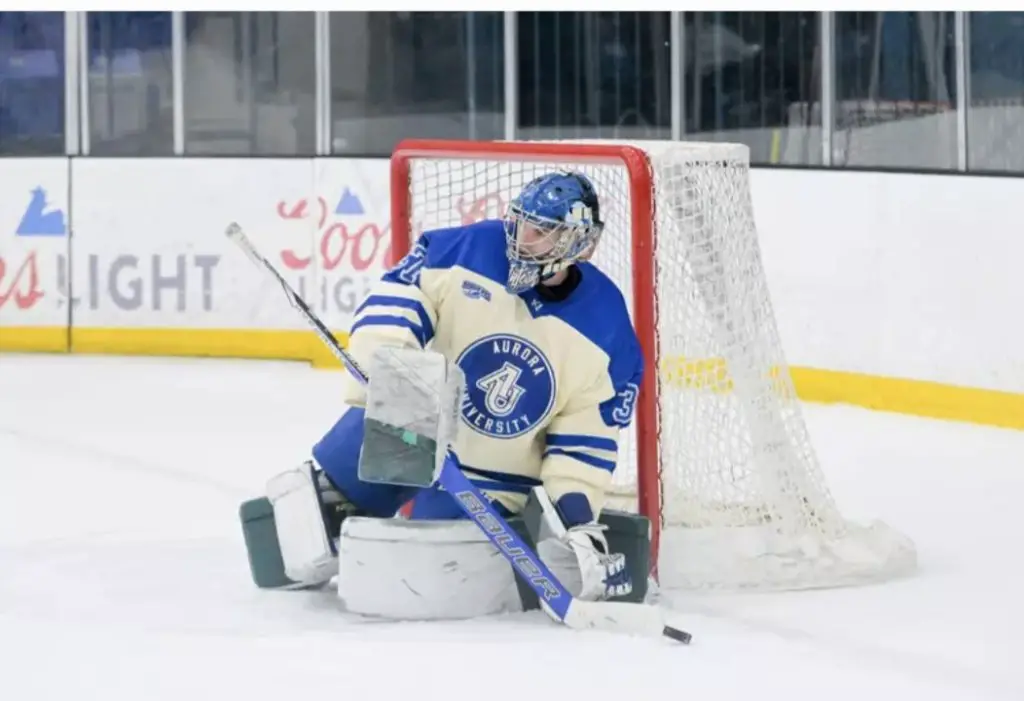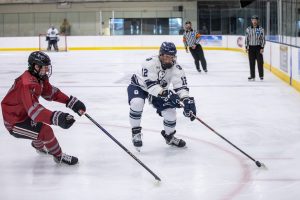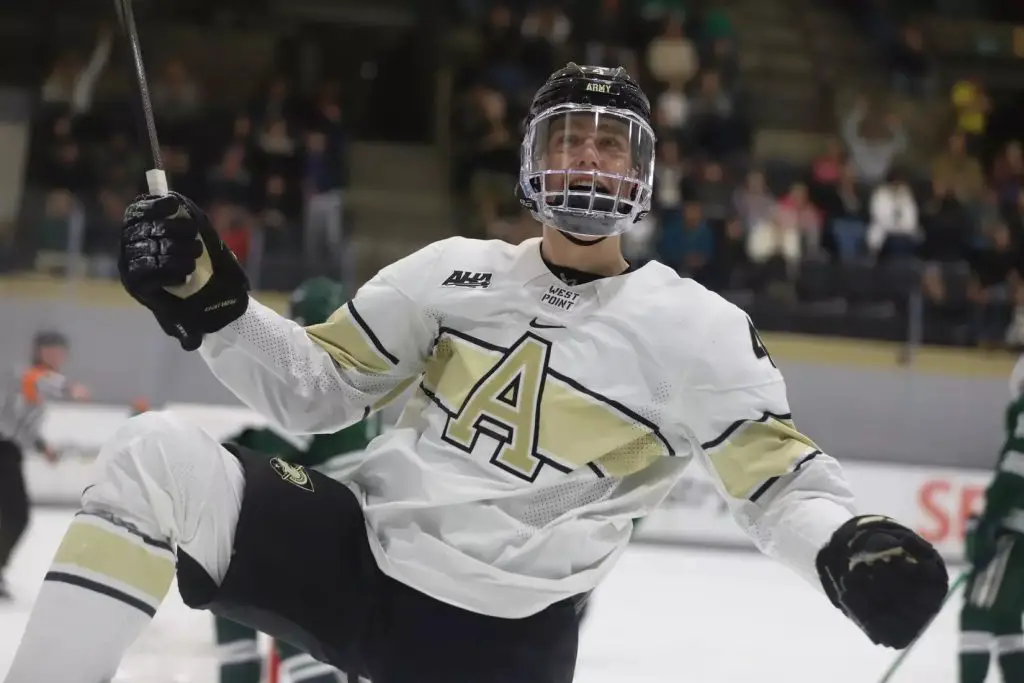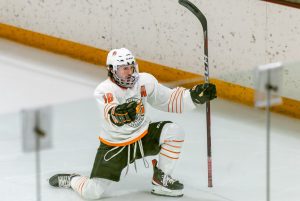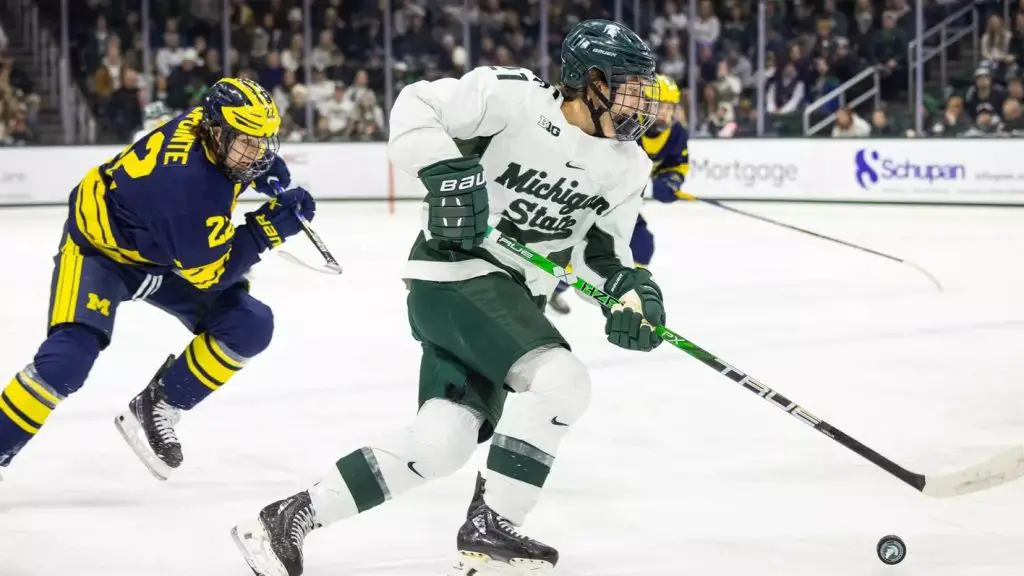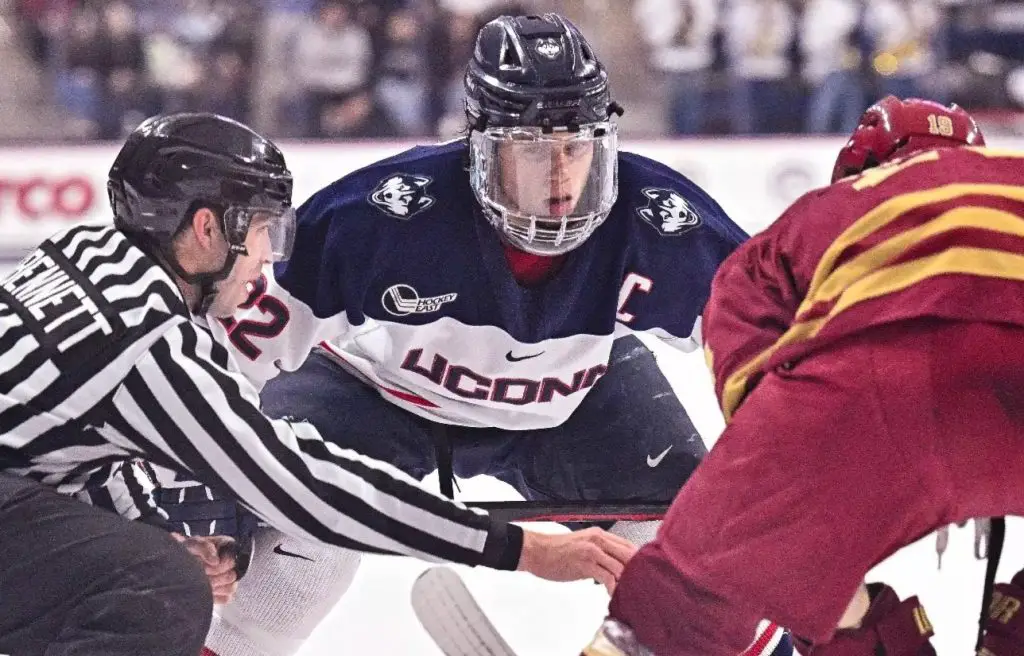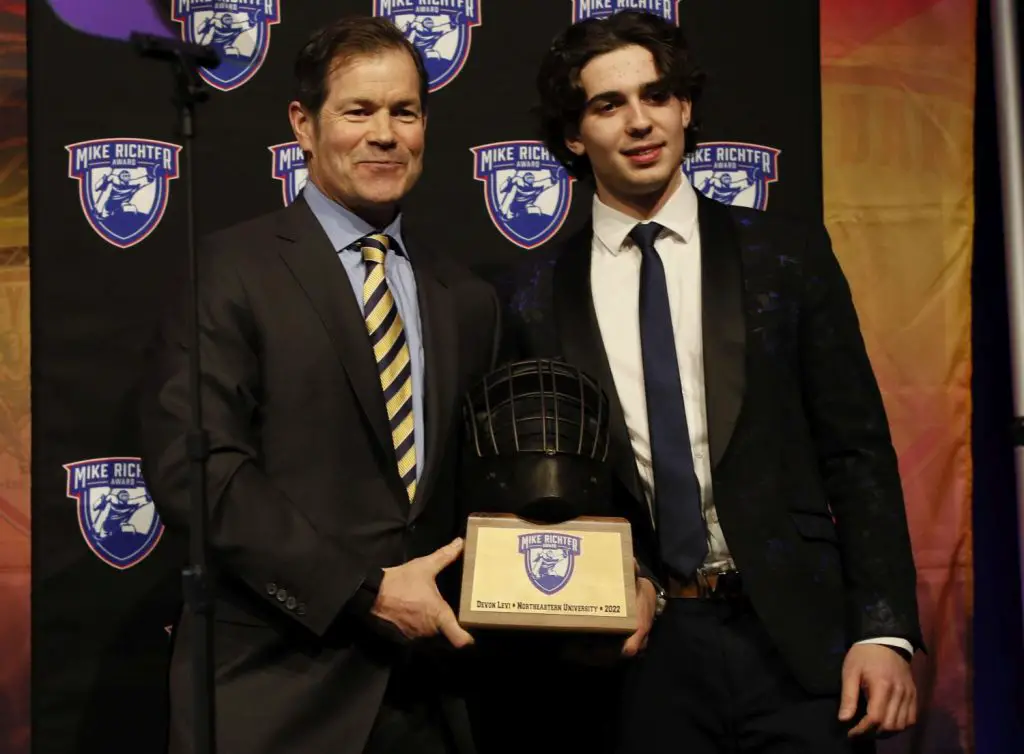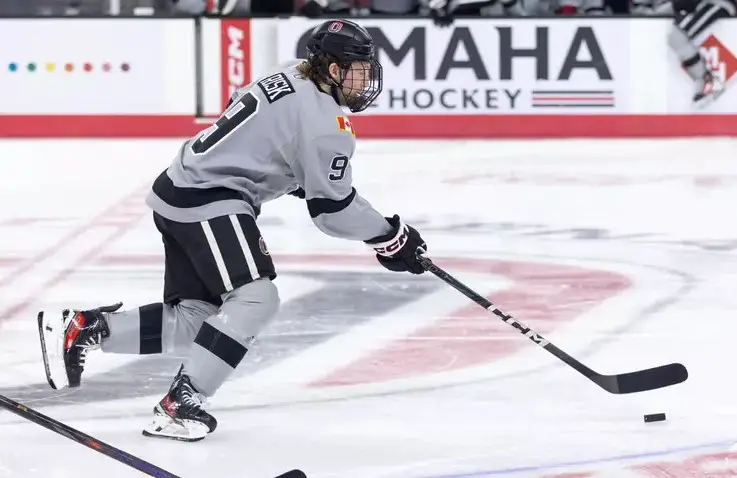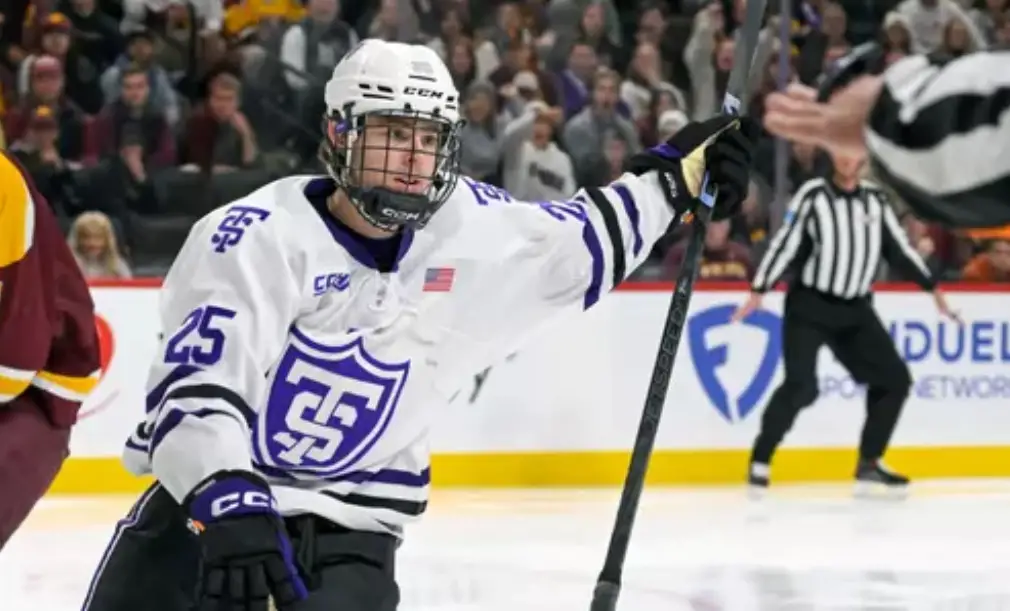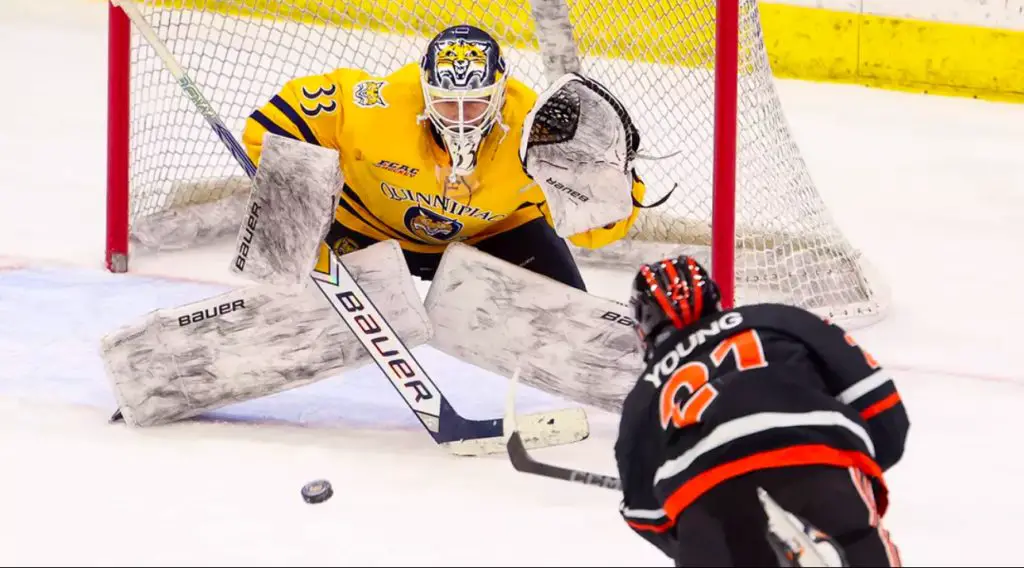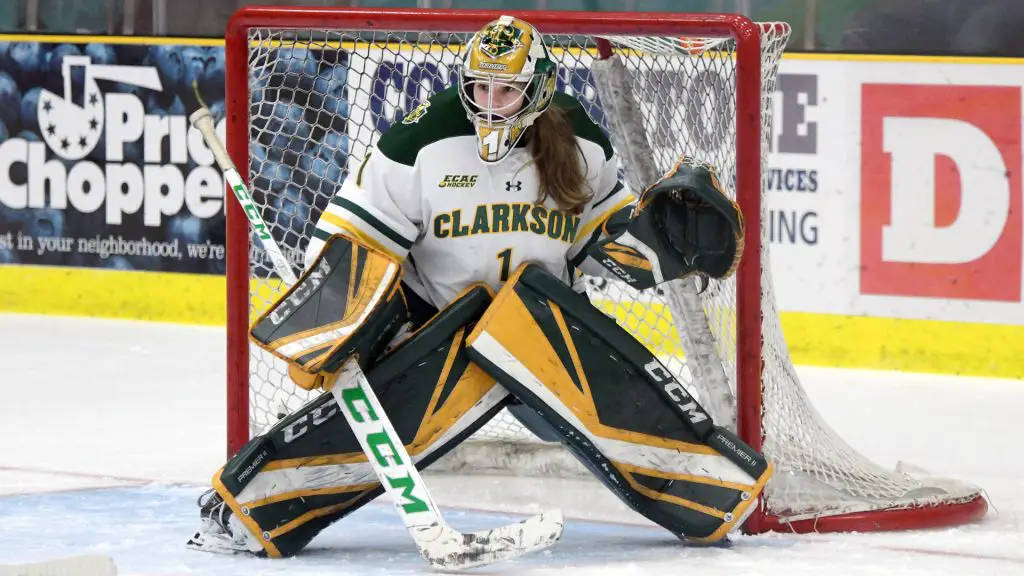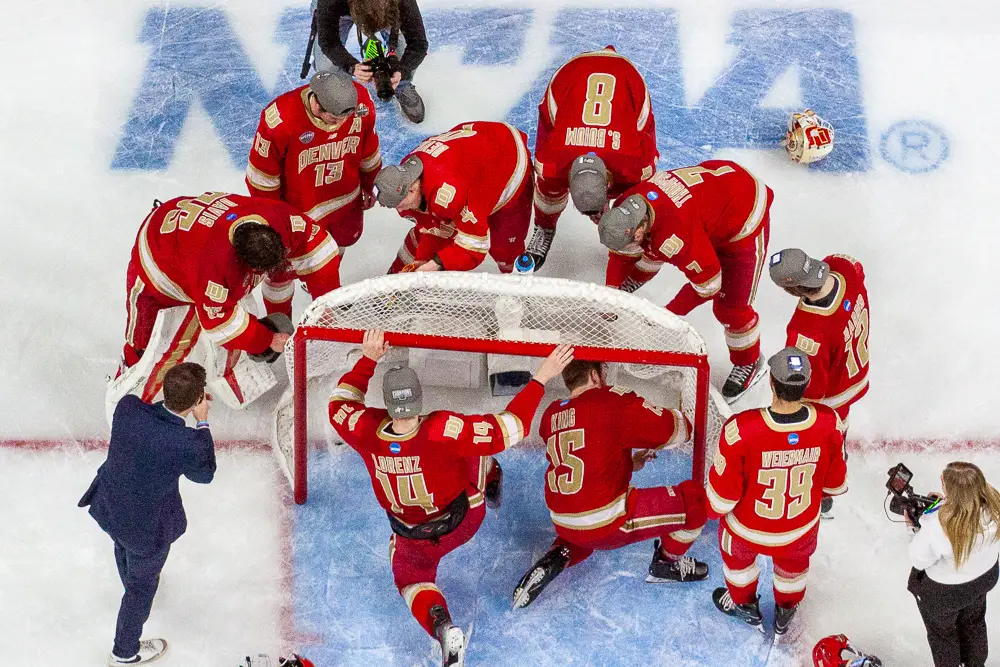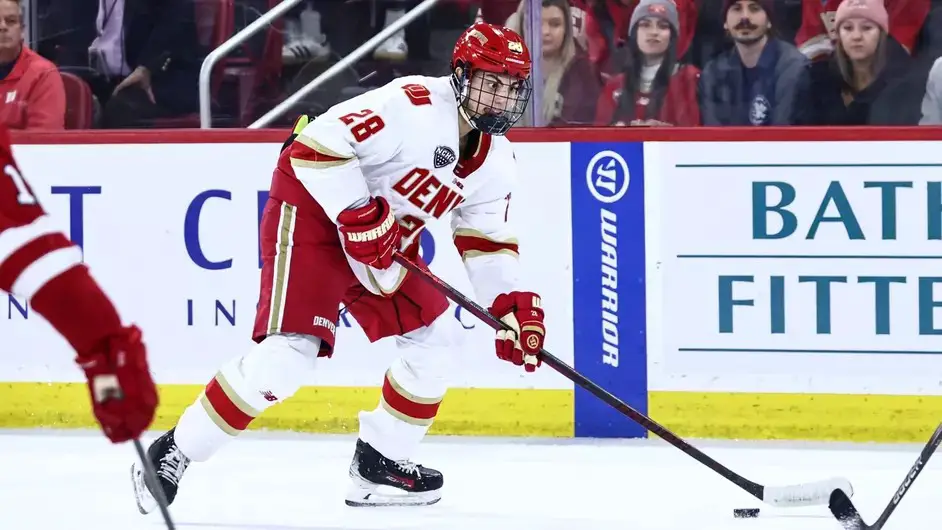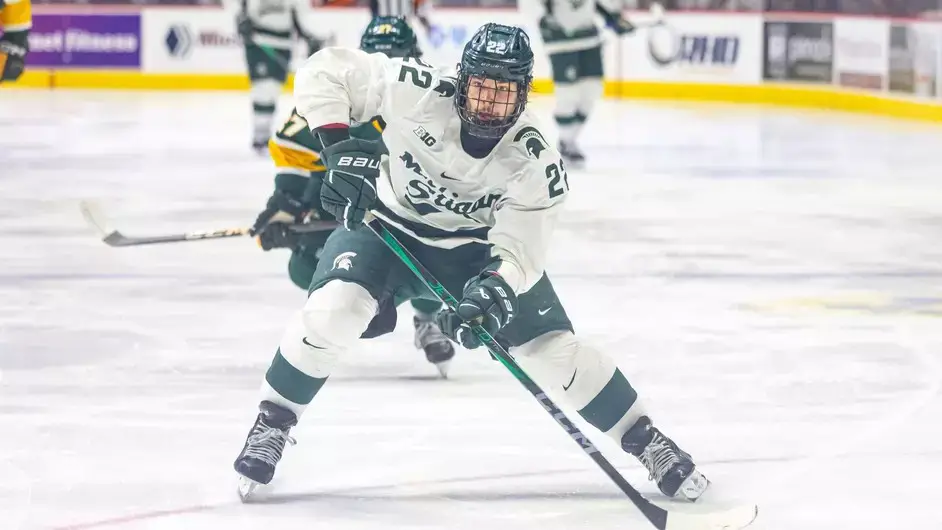
Blake Biondi’s first game-winning goal of the season lifted Notre Dame over Minnesota in overtime, earning the Fighting Irish a tough road split with the No. 3 Golden Gophers.
From the left slot, Biondi took a cross-crease feed from Cole Knuble and one-timed it past Liam Souliere at 3:46 in OT to win the game.
A birds eye view of the game winner 😮💨#GoIrish pic.twitter.com/mocvJvw5dl
— Notre Dame Hockey (@NDHockey) January 19, 2025
After Ian Murphy opened the scoring for the Irish at 7:43 in the first, the Gophers played catch-up for the remainder of the game. The score was tied 1-1 after one when Jimmy Snuggerud answered for Minnesota at 12:33, but the second period ended with a 3-2 Irish lead.
Landon Slaggert scored early in the second to put Notre Dame ahead by one again, with Luke Mittelstadt evening things up three minutes later. Knuble scored late in the second. Matthew Wood’s goal early in the third tied it again for the Gophers.
Each team went 0-for-2 on the power play. Owen Say made 30 saves in his sixth win of the season. Souliere had 27 stops in the game.
SCOREBOARD | STANDINGS | POLL | PAIRWISE
No. 2 Boston College 4, No. 6 Providence 1
Gabe Perreault, James Hagens and Teddy Stiga combined for two goals and Jake Sondreal earned his third game winner of the season as the Eagles beat Providence on the road 4-1, sweeping the home-and-home series.
Jacob Fowler had 30 saves in the win, including this nimble move to preserve a one-goal lead with about a minute left in the second.
Fowler makes a huge save to keep the Eagles in front!
Watch on @ESPNPlus | https://t.co/5Dq6xf7km5 pic.twitter.com/Cs2RHfsHR5
— BC Men's Hockey (@BC_MHockey) January 19, 2025
Perreault put the Eagles up 1-0 after one with assists by Hagens and Stiga. It was 2-1 after two on Sondreal’s goal at 2:06 and Will Elger’s goal on the Friars’ power play at 13:51.
The Eagles added two more in the third, Ryan Leonard’s power-play goal at 8:02 and Stiga’s goal from Perreault and Hagens at 14:03. Stiga also had the second assist on Leonard’s tally.
Philip Svedebäck finished the night with 20 saves for the Friars as Providence outshot Boston College 31-24.
No. 1 Michigan State 4, No. 10 Michigan 1
Charlie Stramel had two goals and an assist and Isaac Howard had three helpers as Michigan State beat Michigan 4-1 in Munn Ice Arena, earning a split in the home-and-home series.
With the Spartans leading 1-0 on Matt Basgall’s early power-play goal, Stramel’s first goal of the night at 18:03 in the first held up as the game winner.
Stramel slams this one home for a 2-0 Spartan lead! West and Howard with the helpers. pic.twitter.com/F71UAsHQMu
— Michigan State Hockey (@MSU_Hockey) January 19, 2025
Michigan State added two more in the second, Shane Vansaghi’s power-play goal at 5:43 and Stramel’s second of the night at 8:12, shorthanded. T.J. Hughes had Michigan’s only score on the power play at 18:50 in the third.
It was a spicy game, with the teams combining for 72 penalty minutes, 48 of which belonged to Michigan. The only goal of the night that didn’t involve special teams play was Stramel’s game winner.
Trey Augustine stopped 34-of-35. Logan Stein made 28 saves in the Michigan net. The Wolverines outshot the Spartans 35-32.
With the win and Minnesota’s loss, the Spartans reclaim the top spot in the Big Ten standings, one point ahead of the Golden Gophers.
No. 4 Western Michigan 5, No. 14 North Dakota 1
After scoring twice in Western Michigan’s Friday overtime win — including the game winner — Alex Bump led Western with two goals and an assist as the Broncos completed a road sweep of North Dakota, beating the Fighting Hawks 5-1.
The Broncos jumped out to a 2-0 lead after after the first period on Ty Henricks’ early goal and this game-winning snipe by Owen Michaels two minutes before the period ended.
Don't blink or you'll miss this one go in! O Mikes with his 10th tally of the season! #BroncosReign pic.twitter.com/6FgvfaPkVS
— WMU Hockey (@WMUHockey) January 19, 2025
Liam Valente gave Western a 3-0 lead at 6:31 in the second. Cameron Berg brought the Fighting Hawks to within two again at 14:24, but Bump’s first of the night with 16 seconds left in the second gave the Broncos a three-goal lead once more. Bump added his second goal on the power play in the third period.
Hampton Slukynsky had the win with 24 saves on 25 shots. T.J. Semptimphelter stopped 37 as the Broncos outshot the Fighting Hawks 42-25.
No. 17 Connecticut 2, No. 5 Maine 2
Down 2-1 and with netminder Callum Tung pulled for the extra skater, Connecticut’s Jake Percival scored from Kai Janviriya with 37 seconds remaining in regulation to tie Maine 2-2 in Alfond Arena and send the game into overtime.
ALL HEART FROM THE HUSKIES!!!! 🗣️
Jake Percival ties it at 2 with the man advantage
Watch:https://t.co/nVUBq4fRWU pic.twitter.com/jnMLNsUEVz
— UConn Men's Hockey (@UConnMHOC) January 19, 2025
It was 1-1 after the first on goals late in the period from Connecticut’s Ryan Tattle and Maine’s Oskar Komarov. After a scoreless second period, Taylor Makar gave the Black Bears the lead at 6:12 in the third.
Through 65 minutes, Maine outshot Connecticut 32-24. Tung had 30 saves for the Huskies and Albin Boija made 22 stops for the Black Bears.
Maine earned the extra shootout point. With the tie and Friday’s 4-2 win, Connecticut took four of a possible six points from Maine on the road.
No. 11 Boston University 2, No. 19 New Hampshire 1 (OT)
New Hampshire threw all it had at Boston University, outshooting the Terriers 35-21, but BU captain Ryan Greene ended the game a minute into overtime on a beauty of an end-to-end play, breaking in with Jack Harvey and giving the Terriers a home-and-home sweep of the Wildcats.
ANOTHER GAME, ANOTHER CLUTCH GOAL BY RYAN GREENE! pic.twitter.com/nrGncRAlgP
— BU Men's Hockey (@TerrierHockey) January 19, 2025
Nick Ring’s goal at 8:27 of the first period gave New Hampshire the early lead. At 7:45 in the second, Cole Eiserman tied the game on the power play. Harvey had the second assist on that goal, making him the only player of the night with a multipoint game.
Mathieu Caron made 34 saves on 35 shots for the win. Jared Whale stopped 19-of-21 for New Hampshire.
Cornell 2, No. 16 Quinnipiac 2 (OT)
Nick DeSantis and Tim Rego each had two points for Cornell as the Big Red came from behind to tie Quinnipiac in M&T Bank Arena, 2-2. DeSantis had the game-tying goal from Rego midway through the third period.
Cornell pushed hard in OT, outshooting the Bobcats 6-0 in the extra stanza. With less than a minute remaining, Dylan Silverstein saved the game for Quinnipiac on a scrambled play in front of the Bobcats’ net.
SILVY BEING SILVY!#BobcatNation x #NCAAHockey pic.twitter.com/ToucCG7AzV
— Quinnipiac Men's Ice Hockey (@QU_MIH) January 19, 2025
George Fegaras gave Cornell the lead from Rego early in the first period, but Tyler Borgula and Chris Pelosi scored in the second for Quinnipiac.
Ian Shane finished the night with 16 saves for Cornell and Silverstein had 17. The Big Red took the extra point in the shootout.
Brown 4, No. 20 Clarkson 2
Max Scott’s first career hat trick — including two scored twice in the final two minutes of regulation – propelled Brown to a 4-2 win over visiting Clarkson, giving the Bears their first season sweep of the Golden Knights in program history.
Scott’s first goal of the night at 8:12 in the second period gave Brown its second lead in the game.
Scott with the finish for his second in as many nights#EverTrue pic.twitter.com/B17bVsVjrd
— Brown Men's Hockey (@BrownU_MHockey) January 18, 2025
Clarkson’s two goals in the game came on the power play, the first by Ellis Rickwood early in the second to tie the game 1-1 and the second by Ayrton Martino at 17:52 in the second, making it a 2-2 game after two.
Scott’s game-winning marker came at 18:35 in the third, followed by an empty-net goal at 19:33.
Lawton Zacher stopped 25-of-27 in the win. In net for the Golden Knights, Ethan Langenegger made 37 saves on 41 shots.
Michigan Tech 1, No. 12 Minnesota State 0 (OT)
After 61 minutes and 45 seconds of scoreless hockey, Michigan Tech’s Isaac Gordon scored on the power play to give the Huskies a 1-0 win over Minnesota State and a split on the weekend at home.
The OT winner for @mtuhky 🚨#NCAAHockey x 🎥 Midco Sportspic.twitter.com/T21K5wdRDW
— NCAA Ice Hockey (@NCAAIceHockey) January 19, 2025
The Mavericks outshot the Huskies 31-25 and went 0-for-4 on the power play.
Ryan Manzella had 31 saves in his second shutout of the season. For Minnesota State, Alex Tracy stopped 24-of-25.
No. 13 Arizona State 5, No. 15 St. Cloud State 3
With the game tied 1-1 after two periods, Arizona State scored three times during a single five-minute power play early in the third on their way to a 5-3 win over St. Cloud State.
This is Ryan Kirwin’s game-winning goal, the third of that man advantage.
THRIVING IN THE CHAOS RN FR FR
Ryan Kirwan nets our third goal of the 5-minute power play :) pic.twitter.com/USU4nVWnlG
— Sun Devil Hockey (@SunDevilHockey) January 19, 2025
All told, the Sun Devils went 4-for-8 on the power play, starting with Lukas Sillinger’s goal at 7:38 in the first to give Arizona State the early 1-0 lead. The game was tied 1-1 heading into the third on Tyson Gross’s second-period goal for St. Cloud.
It was Gross in the box for five minutes for hitting from behind when the Sun Devils took the 4-1 lead. First Noah Beck scored at 2:33, followed by Ty Jackson at 3:18 with Kirwin scoring at 5:35.
St. Cloud answered with goals from Gavyn Thoreson and Daimon Gardner to make it 4-3 late in the third, but Artem Shlaine hit the empty net at 19:14 for the final score. Shlaine led all scorers with his goal plus three assists.
Gibson Homer made 31 saves in the win, and Gavin Enright stopped 20-of-25 for St. Cloud State.
The win gives the Sun Devils a road sweep of the Huskies and sweetens their record to 10-1-0 in their last 11 games. Eight of those 10 wins are in conference play, and the Sun Devils sit at the top of the NCHC standings, a point ahead of Western Michigan.
Ferris State 4, Bowling Green 3
Trailing 2-0 at the end of the first in Ewigleben Arena, the Bulldogs scored four straight goals as Ferris State bested Bowling Green 4-3, halting the Falcons’ unbeaten streak at eight games.
Quinn Emerson and Brody Waters gave the Falcons the 2-0 lead after one, but the Bulldogs tied it up 2-2 after two with goals by Kade Turner and Gavin Best. Turner and Best bookended the period, with Turner scoring his first collegiate goal at 3:21 and Best, who had the second assist on Turner’s goal, scoring with nine seconds left in the period.
Nick Nardecchia’s goal at 3:18 in the third gave the Bulldogs their first lead of the weekend series.
Nick Nardecchia gives @FerrisHockey its first lead of the night!
Watch live on @midcosports
💻: https://t.co/FwkzD2H2rK #CCHAHockey pic.twitter.com/LkwlcImJYH— CCHA (@CCHAHockey) January 19, 2025
Tyler Schleppe’s goal at 5:06 was the game winner after Waters added a power-play goal for Bowling Green at 12:19. Waters leads the CCHA in power-play goals with nine.
Noah West made 38 saves for the Bulldogs. In net for the Falcons, Cole Moore stopped 34 as Bowling Green outshot Ferris State 41-38.
Bowling Green’s streak (7-0-1) dated back to a 3-2 overtime loss to Minnesota State Dec. 7. The win was the first for Ferris State since Dec. 7, ending a five-game losing streak.
Sacred Heart 6, American International 3
The Pioneers extend their unbeaten streak to four games and pad their lead at the top of the Atlantic Hockey standings with their 6-3 home win over American International.
Tyler Ghirardosi had two goals and two assists in the game. Matthew Guerra also had a four-point effort with a goal and three assists. Ghirardosi’s game-winning goal came on the power play at 13:08 in the second.
Ghirardosi off the face-off win and we’re up two! pic.twitter.com/MpWvfYJv4O
— SHU Hockey (@SHUHockey) January 19, 2025
The third period began with the game tied 2-2 before Sacred Heart scored three unanswered, beginning with Cole Galata’s at 6:50. Following Ghirardosi’s game winner, Hunter Sansbury gave the Pioneers a 5-2 lead on the power play at 13:48.
With less than four minutes remaining in regulation, Danny Weight cut the Pioneers’ lead to two goals again, but Guerra hit the empty net from Ghirardosi at 18:28 to cap the scoring.
Cullen DeYoung had 27 saves for the Pioneers. For the Yellow Jackets, Peyton Grainer left the game after the 2:43 mark, stopping all four shots he faced. Chase Clark played the rest of the game for AIC, allowing five goals on 18 shots.

